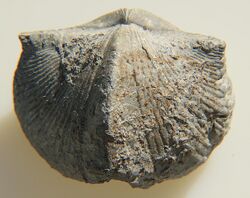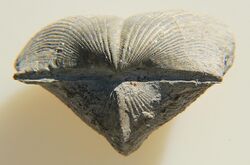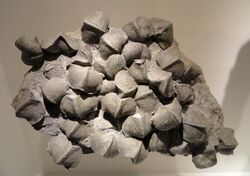Biology:Paraspirifer
| Paraspirifer | |
|---|---|

| |
| Paraspirifer bownockeri, 42mm | |

| |
| Scientific classification | |
| Kingdom: | |
| Phylum: | |
| Class: | |
| Order: | |
| Suborder: | Delthyridina
|
| Superfamily: | Delthyridoidea
|
| Family: | Hysterolitidae
|
| Genus: | Paraspirifer Wedekind, 1926
|
| species | |
| |
Paraspirifer is a genus of large brachiopods (up to about 7.5 centimetres or 3.0 inches) that lived during the late Lower and Middle Devonian in what now are Germany, Spain, Morocco and the United States (New York State and Ohio).
Taxonomy
Paraspirifer developed from Brachyspirifer during the early upper Emsian (cancellata-elegans/Dalehe Event).[2]
Distribution
Paraspirifer originated in the lower upper Emsian and became extinct in Europe and Northern Africa at the end of the lower Eifelian. It survived into the Givetian in North America though.[3]
- P. cultrijugatus is known from the Middle Devonian (Eifelian, Leudersdorf, near Üxheim, Eifel Hills, Germany).[4]
- P. acuminatus occurs in the Middle Devonian of the United States (middle part of the Muscatatuck Group, Indiana)
- P. bownockeri is known from the Middle Devonian of the United States (Givetian of the Appalachian Basin: Lower Silica Formation, Western Ohio; Mount Marion Member of the Oatka Creek Formation and Mottville Member of the Skaneateles Formation, both Eastern and Central New York State).[5]
Ecology
From the type of deposits that contain Paraspirifer bownockeri it can be deduced that this species inhabited soft clay mudflats. Shells of this species hosted a wide range of epibionts, such as bryozoans, corals, echinoderms, annelid worms and other brachiopods. These epibionts are more numerous on the brachial valve than on the pedunculate valve, because this big brachiopod lay on its pedunculate valve after the degeneration of the stalk.[6][7]
References
- ↑ Pardo Alonso, M.V. (2002). "Revisión de Paraspirifer chillonensis (Quintero y Revilla, 1966), del Devónico inferior de Almadén (España)". Boletín Geológico y Minero 113 (1): 71–84. ISSN 0366-0176. http://www.igme.es/internet/Boletin/2002/113_1_2002/9-ARTICULO%20REVISION%20DE%20....pdf.
- ↑ May, Andreas; Avlar, Hüseyin (1995). "Evolution of Rhenisch faunal communities during the Late Emsian and Early Eifelian: three reviews on sedimentation, brachiopods and bioevents". Geolines 3: 50-.
- ↑ May, Andreas (2007). "Reply to the critical Review by Francesco de Soto on the paper of A. May "Radeastraea (Anthozoa, Rugosa) from the Emsian and Eifelian (Devonian) of Aviados, Northern Spain". Bulletin of Geosciences 82 (3): 293–296. doi:10.3140/bull.geosci.2007.03.293. http://www.geology.cz/bulletin/fulltext/bullgeosci200703293.pdf.
- ↑ Detlev. "Paraspirifer cultrijugatus". http://brachiopoda.xooit.fr/t357-Famille-des-HYSTEROLITIDAE-Paraspirifer-cultrijugatus.htm.
- ↑ Bartholomew, A.E .; Brett, C. E. (2007). "Correlation of Middle Devonian Hamilton Group-equivalent strata in east-central North America: implications of eustacy, tectonics and faunal provinciality". Devonian Events and Correlations. Geological Society special publication (278). https://books.google.com/books?id=3hLRklY9pYEC&pg=PA111.
- ↑ Kesling, Robert V.; Hoare, Richard D.; Sparks, Diane K. (1980). "Epizoans of the Middle Devonian brachiopod Paraspirifer bownockeri: their relationship to one another and their host". Journal of Paleontology 54 (6): 1141–1154.
- ↑ Hoare, Richard D.; Walden, R. L.. "Vermiforichnus (Polychaeta) Borings in Paraspirifer bownockeri (Brachiopoda: Devonian)". Ohio Journal of Science 83 (3): 114–119. https://kb.osu.edu/dspace/bitstream/handle/1811/22930/V083N3_114.pdf?sequence=1.
Wikidata ☰ Q16987487 entry
 |


